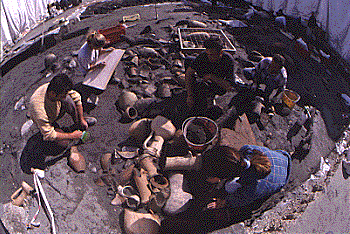

| |
| Other Ships |
"A Cache of Vintage Ships" Volume 52 Number 4, July/August 1999 |
 |
| A jumble of amphora sherds and a few scraps of wood are all that remain of the so-called ghost ship. |
The sixth ship, preserved over a length of 26 feet, is most remarkable for its cargo, primarily amphoras stacked in rows and still in place. According to Bruni, "The amphoras, of various types and mostly sealed, contained some liquid residues--now under analysis, but resembling wine--cherry, plum, and olive pits, and sand. Analysis of the sand and study of the cobbles [used as ballast or to prop up amphoras stacked in the hold], many of Vesuvian lava, show that the cargo originated somewhere on the Bay of Naples." Why would amphoras be filled with sand? Pozzolana, a red dust from Pozzuoli on the Bay of Naples, was used in the imperial period for concrete that would set under water. "Objects related to life on board were also plentiful," say Bruni: "pottery cups, lamps, a glass cup, leather objects, and coins."
Of the three other ships, little so far is known. Excavators called one the "ghost ship" because they toiled for weeks on its cargo of amphoras, finding only scraps of the ship itself. Two others are in the very first stages of excavation. In addition, a short section of a stone quay has been found, along with a mass of cobbles (probably discarded ballast) from a beach near Portoferraio on the island of Elba, 60 miles down the coast. 
Introduction | Ship A | Ship B | Ship C | Ship D | Other Ships | A New Museum?
© 1999 by the Archaeological Institute of America archive.archaeology.org/9907/etc/other.html |
Advertisement

Advertisement






